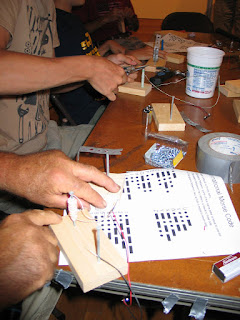We made rubber band race cars with Windsor kids this month in collaboration with the public library's "Ready, Set, Go" summer reading program. There are lots of instructions on the web for making these little cars. Ours involved old CDs, paper towel tubes, buttons, glue guns, and rubber bands.
When the kids arrived, we had a prototype to show them, all the materials laid out, and we dove right in. All the kids were able to make their cars without much trouble....or innovation. I always struggle with finding a balance between having a set project that will meet with success, yet also allow kids to struggle and solve problems. In this case, the project was straightforward. Except, it wasn't.
After getting his car ready to go, one little boy kept saying "it doesn't work, it doesn't work." All the other cars around him were spinning across the floor as if by magic. He was so frustrated.
And then I realized that I had fallen into a trap--the "focus on the end goal trap." We, the adults, had jumped right in to making the cars without taking the time to talk about the mechanics of how they worked. Finally, just as the workshop ended, he started to understand how the rubber band made the car go.
We had held a maker session, but jumped over the learning. Well, I learned something!


























